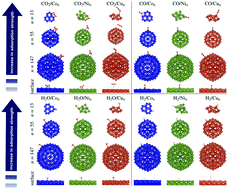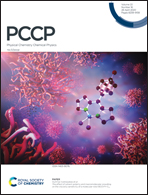Ab initio investigation of quantum size effects on the adsorption of CO2, CO, H2O, and H2 on transition-metal particles†
Abstract
Adsorption is a crucial preliminary step for the conversion of CO2 into higher-value chemicals, nonetheless, the atomistic understanding of how substrate particle size affects this step is still incomplete. In this study, we employed density functional theory to investigate the effects of particle size on the adsorption of model molecules involved in the CO2 transformations (CO2, CO, H2O and H2) on Con, Nin and Cun particles with different sizes (n = 13, 55, 147) and on the respective close-packed surfaces. We found significant size-dependence of the adsorption properties for physisorbed (linear) and chemisorbed (bent) CO2 on the substrates and distinct (symmetric or asymmetric) stretching of the C–O bonds, which can play a crucial role to understand the CO2 dissociation pathways. For CO and H2, some properties showed small oscillations, due to size effects that induced alternation of the adsorption site preference for different particle sizes; for H2O, the adsorption properties were almost independent of particle size. The presence of low-coordinated adsorption sites resulted in a trend for stronger adsorption and greater charge transfer for smaller clusters. Fixing the size-independent factors (e.g., type of metal), our results show that CO2 adsorption on transition-metal clusters is significantly affected by particle size, suggesting that substrate particle size could be a key factor to understand and control the catalytic transformations of CO2.



 Please wait while we load your content...
Please wait while we load your content...